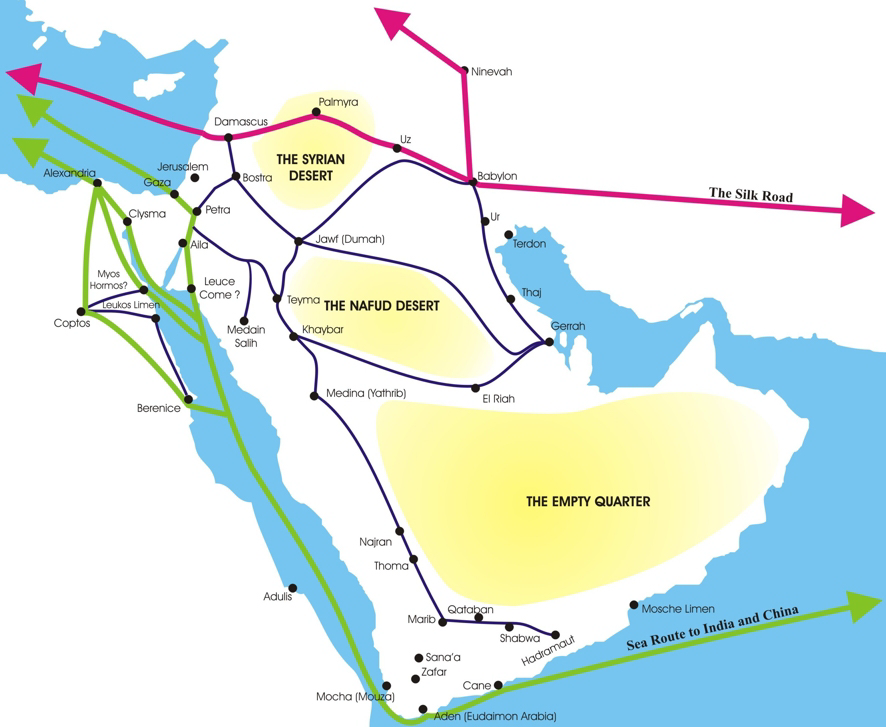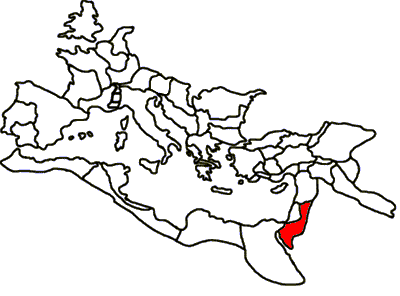|
Nabatean Kingdom
The Nabataean Kingdom ( Nabataean Aramaic: 𐢕𐢃𐢋𐢈 ''Nabāṭū''), also named Nabatea (), was a political state of the Arab Nabataeans during classical antiquity. The Nabataean Kingdom controlled many of the trade routes of the region, amassing large wealth and drawing the envy of its neighbors. It stretched south along the Red Sea coast into the Hejaz, up as far north as Damascus, which it controlled for a short period (85–71 BC). Nabataea remained an independent political entity from the mid-3rd century BC until it was annexed in AD 106 by the Roman Empire, which renamed it Arabia Petraea. History Nabataeans The Nabataeans were one among several nomadic Bedouin tribes that roamed the Arabian Desert and moved with their herds to wherever they could find pasture and water. They became familiar with their area as seasons passed, and they struggled to survive during bad years when seasonal rainfall diminished. Although the Nabataeans were initially embedded in A ... [...More Info...] [...Related Items...] OR: [Wikipedia] [Google] [Baidu] |
Ancient History
Ancient history is a time period from the beginning of writing and recorded human history to as far as late antiquity. The span of recorded history is roughly 5,000 years, beginning with the Sumerian cuneiform script. Ancient history covers all continents inhabited by humans in the period 3000 BCAD 500. The three-age system periodizes ancient history into the Stone Age, the Bronze Age, and the Iron Age, with recorded history generally considered to begin with the Bronze Age. The start and end of the three ages varies between world regions. In many regions the Bronze Age is generally considered to begin a few centuries prior to 3000 BC, while the end of the Iron Age varies from the early first millennium BC in some regions to the late first millennium AD in others. During the time period of ancient history, the world population was already exponentially increasing due to the Neolithic Revolution, which was in full progress. While in 10,000 BC, the world population st ... [...More Info...] [...Related Items...] OR: [Wikipedia] [Google] [Baidu] |
Aretas IV
Aretas IV Philopatris (Nabataean Aramaic: 𐢗𐢓𐢆 𐢊𐢛𐢞𐢞 𐢛𐢊𐢒 ''Ḥārīṯat Rāḥem-ʿammeh'', "Aretas, friend of his people") was the King of the Nabataeans from roughly 9 BC to AD 40. His daughter Phasaelis was married to, and divorced from, Herod Antipas. Herod then married his stepbrother's wife, Herodias. It was opposition to this marriage that led to the beheading of John the Baptist. After he received news of the divorce, Aretas invaded the territory of Herod Antipas and defeated his army. Rise to power Aretas came to power after the assassination of Obodas III, who was apparently poisoned. Josephus says that he was originally named Aeneas, but took "Aretas" as his throne name. An inscription from Petra suggests that he may have been a member of the royal family, as a descendant of Malichus I. The capital of his kingdom was a prosperous trading city, Petra, some 170 miles south of Amman. Petra is famous for the many monuments carved into ... [...More Info...] [...Related Items...] OR: [Wikipedia] [Google] [Baidu] |
Aramean
The Arameans ( oar, 𐤀𐤓𐤌𐤉𐤀; arc, 𐡀𐡓𐡌𐡉𐡀; syc, ܐܪ̈ܡܝܐ, Ārāmāyē) were an ancient Semitic-speaking people in the Near East, first recorded in historical sources from the late 12th century BCE. The Aramean homeland was known as the land of Aram and encompassed central regions of modern Syria. At the beginning of the 1st millennium BCE, a number of Aramean states were established throughout the western regions of the ancient Near East. The most notable was the Kingdom of Aram-Damascus, which reached its height in the second half of the 9th century BCE during the reign of king Hazael. A distinctive Aramaic alphabet was developed and used to write the Old Aramaic language. During the 8th century BCE, local Aramean kingdoms were gradually conquered by the Neo-Assyrian Empire. The policy of population displacement and relocation that was applied throughout Assyrian domains also affected Arameans, many of whom were resettled by Assyrian auth ... [...More Info...] [...Related Items...] OR: [Wikipedia] [Google] [Baidu] |
Bedouin
The Bedouin, Beduin, or Bedu (; , singular ) are nomadic Arabs, Arab tribes who have historically inhabited the desert regions in the Arabian Peninsula, North Africa, the Levant, and Mesopotamia. The Bedouin originated in the Syrian Desert and Arabian Desert but spread across the rest of the Arab world in Western Asia, West Asia and North Africa after the spread of Islam. The English word ''bedouin'' comes from the Arabic ''badawī'', which means "desert dweller", and is traditionally contrasted with ''ḥāḍir'', the term for Sedentism, sedentary people. Bedouin territory stretches from the vast deserts of North Africa to the rocky sands of the Middle East. They are traditionally divided into tribes, or clans (known in Arabic as ''ʿašāʾir''; or ''qabāʾil'' ), and historically share a common culture of herding camels and goats. The vast majority of Bedouins adhere to Islam, although there are some fewer numbers of Arab Christians, Christian Bedouins present in the Fe ... [...More Info...] [...Related Items...] OR: [Wikipedia] [Google] [Baidu] |
Arabia Petraea
Arabia Petraea or Petrea, also known as Rome's Arabian Province ( la, Provincia Arabia; ar, العربية البترائية; grc, Ἐπαρχία Πετραίας Ἀραβίας) or simply Arabia, was a frontier province of the Roman Empire beginning in the 2nd century. It consisted of the former Nabataean Kingdom in Jordan, southern Levant, the Sinai Peninsula and northwestern Arabian Peninsula. Its capital was Petra. It was bordered on the north by Syria, on the west by Judaea (merged with Syria from AD 135) and Egypt, and on the south and east by the rest of Arabia, known as Arabia Deserta and Arabia Felix. The territory was annexed by Emperor Trajan, like many other eastern frontier provinces of the Roman Empire, but held onto, unlike Armenia, Mesopotamia and Assyria, well after Trajan's rule, its desert frontier being called the Limes Arabicus. It produced the Emperor Philippus, who was born around 204. As a frontier province, it included a desert populated ... [...More Info...] [...Related Items...] OR: [Wikipedia] [Google] [Baidu] |
Damascus
)), is an adjective which means "spacious". , motto = , image_flag = Flag of Damascus.svg , image_seal = Emblem of Damascus.svg , seal_type = Seal , map_caption = , pushpin_map = Syria#Mediterranean east#Arab world#Asia , pushpin_label_position = right , pushpin_mapsize = , pushpin_map_caption = Location of Damascus within Syria , pushpin_relief = 1 , coordinates = , subdivision_type = Country , subdivision_name = , subdivision_type1 = Governorate , subdivision_name1 = Damascus Governorate, Capital City , government_footnotes = , government_type = , leader_title = Governor , leader_name = Mohammad Tariq Kreishati , parts_type = Municipalities , parts = 16 , established_title = , established_date ... [...More Info...] [...Related Items...] OR: [Wikipedia] [Google] [Baidu] |
Hejaz
The Hejaz (, also ; ar, ٱلْحِجَاز, al-Ḥijāz, lit=the Barrier, ) is a region in the west of Saudi Arabia. It includes the cities of Mecca, Medina, Jeddah, Tabuk, Yanbu, Taif, and Baljurashi. It is also known as the "Western Province" in Saudi Arabia.Mackey, p. 101. "The Western Province, or the Hejaz .. It is bordered in the west by the Red Sea, in the north by Jordan, in the east by the Najd, and in the south by the 'Asir Region. Its largest city is Jeddah (the second largest city in Saudi Arabia), with Mecca and Medina being the fourth and fifth largest cities respectively in the country. The Hejaz is the most cosmopolitan region in the Arabian Peninsula. The Hejaz is significant for being the location of the Islamic holy cities of Mecca and Medina, the first and second holiest sites in Islam, respectively. As the site of the two holiest sites in Islam, the Hejaz has significance in the Arab and Islamic historical and political landscape. The region o ... [...More Info...] [...Related Items...] OR: [Wikipedia] [Google] [Baidu] |
Tihamah
Tihamah or Tihama ( ar, تِهَامَةُ ') refers to the Red Sea coastal plain of the Arabian Peninsula from the Gulf of Aqaba to the Bab el Mandeb. Etymology Tihāmat is the Proto-Semitic language's term for ' sea'. Tiamat (or Tehom, in masculine form) was the ancient Mesopotamian god of the sea and of chaos. The word appears in the Hebrew Bible as təhōm (Genesis 1:2), meaning "primordial ocean, abyss". History Era of Muhammad During the era of the Islamic prophet Muhammad, many military expeditions took place here including the Battle of Hamra al-Asad and caravan raids. Beginning in January 623 CE, some of the Muslims resorted to the tradition of raiding the Meccan caravans that traveled along the eastern coast of the Red Sea from Mecca to the Syrian region. While at Ḥamra' al-Asad (), Muhammad made an agreement with Mabad al-Khuzaah at Tihamah, in which Mabad pledged not to conceal anything from him. Mabad was then sent to Mecca to dissuade Abu Sufyan ibn ... [...More Info...] [...Related Items...] OR: [Wikipedia] [Google] [Baidu] |
Red Sea
The Red Sea ( ar, البحر الأحمر - بحر القلزم, translit=Modern: al-Baḥr al-ʾAḥmar, Medieval: Baḥr al-Qulzum; or ; Coptic: ⲫⲓⲟⲙ ⲛ̀ϩⲁϩ ''Phiom Enhah'' or ⲫⲓⲟⲙ ⲛ̀ϣⲁⲣⲓ ''Phiom ǹšari''; Tigrinya: ቀይሕ ባሕሪ ''Qeyih Bahri''; ) is a seawater inlet of the Indian Ocean, lying between Africa and Asia. Its connection to the ocean is in the south, through the Bab el Mandeb strait and the Gulf of Aden. To its north lie the Sinai Peninsula, the Gulf of Aqaba, and the Gulf of Suez (leading to the Suez Canal). It is underlain by the Red Sea Rift, which is part of the Great Rift Valley. The Red Sea has a surface area of roughly 438,000 km2 (169,100 mi2), is about 2250 km (1398 mi) long, and — at its widest point — 355 km (220.6 mi) wide. It has an average depth of 490 m (1,608 ft), and in the central ''Suakin Trough'' it reaches its maximum depth of . The Red Sea also ha ... [...More Info...] [...Related Items...] OR: [Wikipedia] [Google] [Baidu] |
Classical Antiquity
Classical antiquity (also the classical era, classical period or classical age) is the period of cultural history between the 8th century BC and the 5th century AD centred on the Mediterranean Sea, comprising the interlocking civilizations of ancient Greece and ancient Rome known as the Greco-Roman world. It is the period in which both Greek and Roman societies flourished and wielded huge influence throughout much of Europe, North Africa, and Western Asia. Conventionally, it is taken to begin with the earliest-recorded Epic Greek poetry of Homer (8th–7th-century BC), and continues through the emergence of Christianity (1st century AD) and the fall of the Western Roman Empire (5th-century AD). It ends with the decline of classical culture during late antiquity (250–750), a period overlapping with the Early Middle Ages (600–1000). Such a wide span of history and territory covers many disparate cultures and periods. ''Classical antiquity'' may also refer to an ... [...More Info...] [...Related Items...] OR: [Wikipedia] [Google] [Baidu] |
Nabataeans
The Nabataeans or Nabateans (; Nabataean Aramaic: , , vocalized as ; Arabic: , , singular , ; compare grc, Ναβαταῖος, translit=Nabataîos; la, Nabataeus) were an ancient Arab people who inhabited northern Arabia and the southern Levant. Their settlements—most prominently the assumed capital city of Raqmu (present-day Petra, Jordan)—gave the name ''Nabatene'' ( grc, Ναβατηνή, translit=Nabatēnḗ) to the Arabian borderland that stretched from the Euphrates to the Red Sea. The Nabateans emerged as a distinct civilization and political entity between the 4th and 2nd centuries BCE,Taylor, Jane (2001). ''Petra and the Lost Kingdom of the Nabataeans''. London: I.B.Tauris. pp. 14, 17, 30, 31. . Retrieved 8 July 2016. with their kingdom centered around a loosely controlled trading network that brought considerable wealth and influence across the ancient world. Described as fiercely independent by contemporary Greco-Roman accounts, the Nabataeans were annexed ... [...More Info...] [...Related Items...] OR: [Wikipedia] [Google] [Baidu] |






.jpg)


